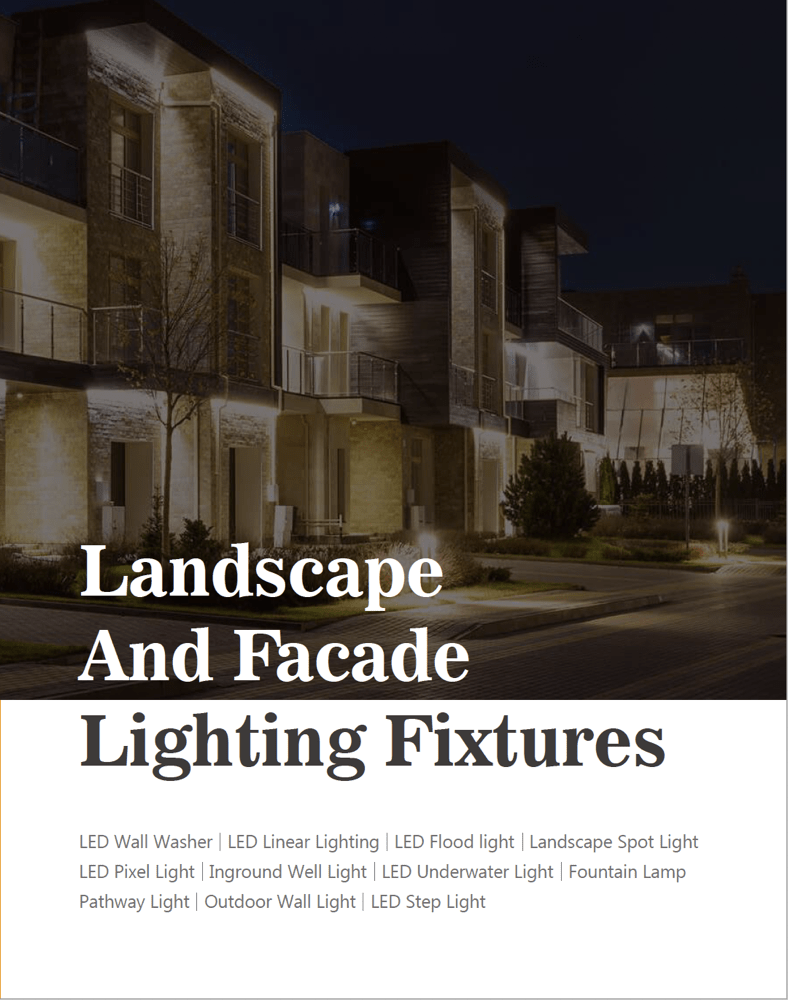Imagine a city skyline at night. The buildings that stand out aren’t just the tallest, but those brilliantly lit, showcasing their design. That’s the magic of facade lighting. It’s more than just bulbs and beams; it’s about turning buildings into nighttime masterpieces.
With 18 years experience in the LED industry, we’ve seen and shaped this transformation. We understand the nuts and bolts of facade lighting, and in this guide, we’ll share that knowledge. Dive in to discover how the right lighting can elevate any structure from ordinary to iconic.
The Evolution of Facade Lighting
As we stand amidst the dazzling lights of today’s cities, it’s easy to forget the journey facade lighting has undertaken. From the humble flicker of lanterns to the dynamic displays of modern LEDs, the story of facade lighting is as illuminating as the lights themselves. Let’s journey back in time and trace the luminous footsteps of this evolution.
- A Glimpse into the Past: In bygone days, the gentle flicker of lanterns and torches illuminated buildings, serving a simple purpose: to light up streets and structures after the sunset.
- The Electric Revolution: The dawn of electricity transformed our cities. Incandescent bulbs took over, making buildings shine brighter and adding a new dimension to nighttime aesthetics.
- Neon Nights: Come the 20th century, neon lights painted towns in vibrant colors. Streets were adorned with iconic signs, turning buildings into radiant displays of art.
- The LED Era: LEDs ushered in a new age of facade lighting. Energy-efficient, colorful, and versatile, they turned buildings into dynamic canvases, showcasing mesmerizing light shows and interactive spectacles.The fusion of LED technology with modern controls has revolutionized facade lighting, blending aesthetics with sustainability, safety, and architectural harmony.
As we marvel at today’s illuminated skyscrapers, we’re not just seeing lights; we’re witnessing a rich tapestry of history, innovation, and creativity in facade lighting.
What Is Facade Lighting And Why It Matters?
Imagine walking through a city at night, where buildings come alive with lights, telling stories and showcasing their beauty. This magic? It’s all thanks to facade lighting.
Facade lighting is the strategic illumination of a building’s exterior, primarily aimed at accentuating its architectural features and enhancing its aesthetic appeal. It’s more than just placing lights; it’s about showcasing a structure’s design, ensuring safety, and creating a captivating nighttime visual experience. By highlighting specific elements or providing a general glow, facade lighting not only elevates a building’s presence in its surroundings but also plays a vital role in security, making spaces feel welcoming and deterring potential threats. Facade lighting is where architecture meets art, turning ordinary structures into landmarks.
Every corner of our world boasts architectural masterpieces, and behind their nighttime splendor is the art of facade lighting. Consider the iconic Sydney Opera House in Australia or the towering Burj Khalifa in Dubai. These structures don’t just light up; they transform, offering dynamic displays that captivate and inspire. Tokyo Tower in Japan, for instance, changes its illumination with the seasons, reflecting the city’s vibrant spirit.
In today’s world, where design and innovation go hand in hand, the possibilities with facade lighting are endless. Architects and designers have a vast array of lighting products at their disposal, allowing them to bring their visions to life. Whether illuminating a commercial skyscraper, a historical monument, or a cozy home, facade lighting is essential. It’s not just about making a building visible at night; it’s about giving it a personality, making it stand out, and creating lasting impressions.
So, the next time you’re out at night, and a building captures your attention with its mesmerizing lights, remember the art and science of facade lighting that’s at play. It’s not just about brightness; it’s about creating moments and memories.
Types of Facade Lighting: Design Meets Illumination
When it comes to facade lighting, the design of the facade and the type of lighting used are intertwined. Different facades possess distinct characteristics, and the perfect lighting can enhance these traits. Here, we delve into various facade designs and the LED lighting options tailored for them:
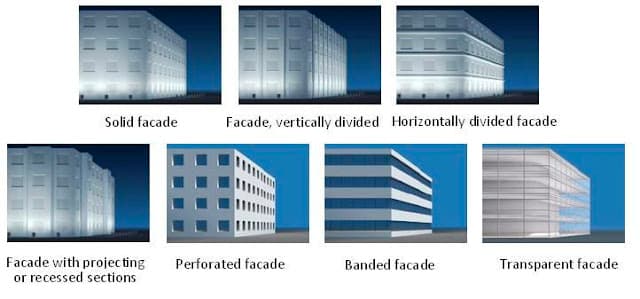
Solid Facade
A solid facade represents a smooth wall without intricate designs, commonly found in many buildings. For instance, New York’s One World Trade Center showcases a solid facade that captures the sky during the day and, at night, becomes a canvas for LED wall washers and linear LED strips. These facades, given their lack of design variations, benefit from natural lighting techniques. With their expansive smooth surfaces, they can accommodate a variety of facade lighting. Designers often mix different light temperatures and variations to craft stunning visuals. LED wall washers or linear LED strips are ideal for these facades, providing consistent illumination that emphasizes their sheer size and uniformity.
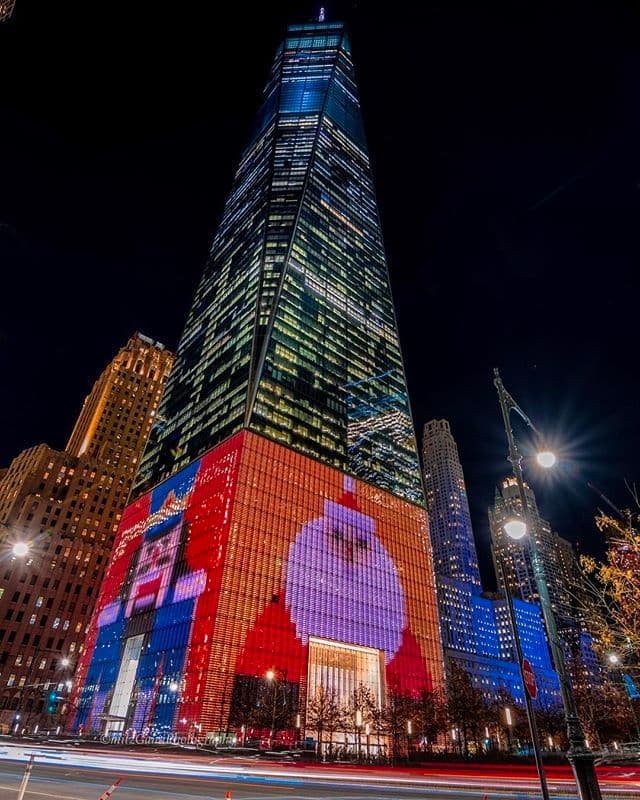
Vertically Divided Facade
Buildings with vertically divided facades showcase dominant vertical elements or patterns, lending them a sense of height and majesty. The Shard in London, with its clear vertical divisions, is a prime example. Vertical LED strips or spotlights, placed at regular intervals, can accentuate this design, casting a rhythmic dance of light and shadow that elevates the building’s stature.
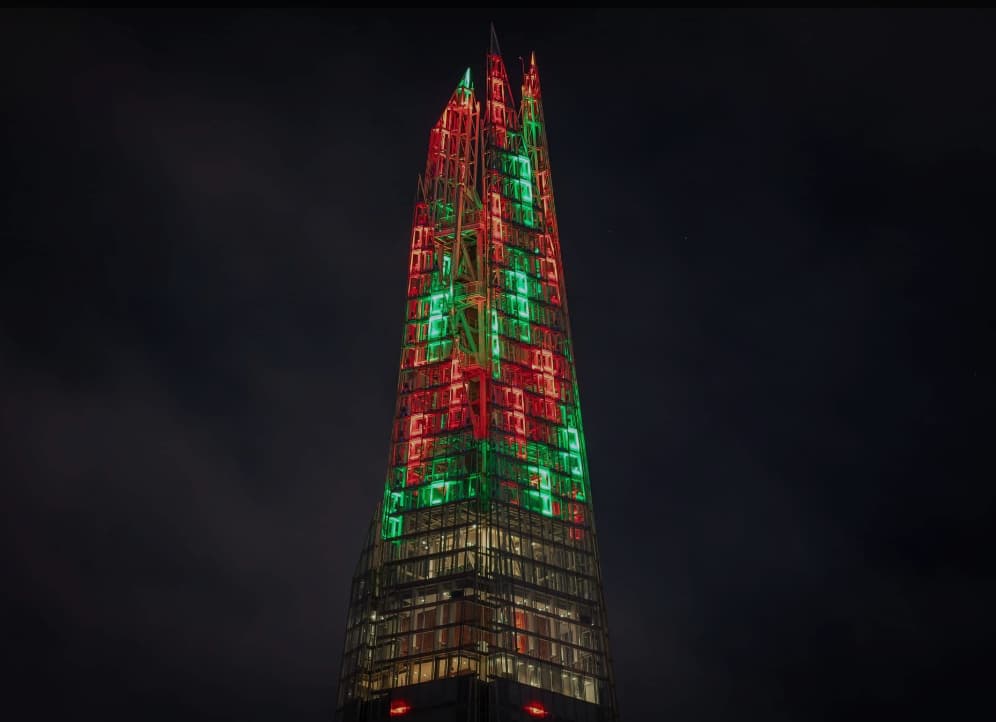
Horizontally Divided Facade
Horizontally divided facades are defined by their distinct horizontal layers. The Jenga-like 56 Leonard Street in New York offers a unique take on this design, with each layer seeming to float above the other. Horizontal LED strips or linear lights, emphasizing each layer, can illuminate these facades, highlighting their layered design elements.
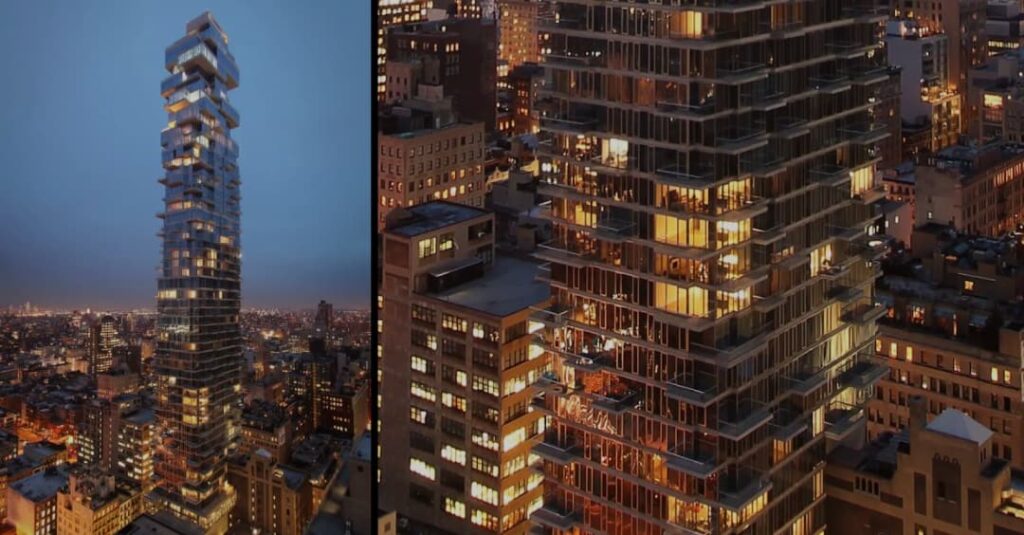
Perforated Facade
Perforated facades, with their multiple openings or perforations, offer intriguing light and shadow plays. The Elbphilharmonie in Hamburg stands as a testament to the beauty of perforated designs. The dance of patterns created as light filters through these openings is mesmerizing. Recessed LED downlights or spotlights can craft these dramatic effects, painting the building as a luminous work of art. Such designs underscore the importance of choosing the right lighting.
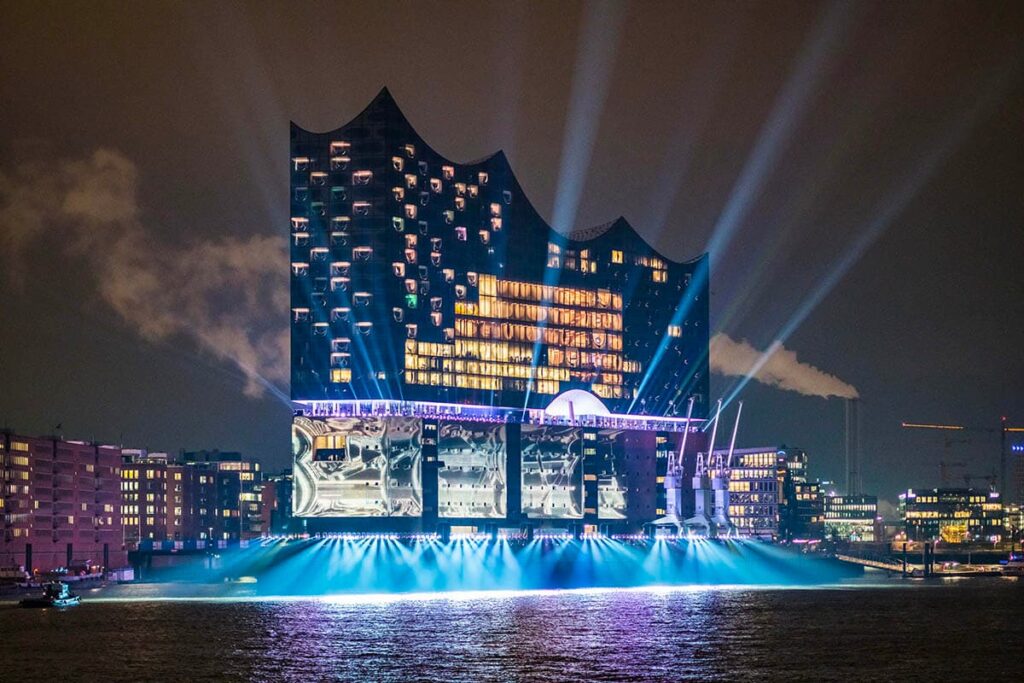
Historic or Heritage Facade
Historic buildings carry the weight of centuries, telling stories of eras gone by. Their facades, often adorned with intricate carvings, sculptures, and architectural elements from their respective periods, require a delicate touch when it comes to lighting.
Example: Notre-Dame Cathedral, Paris
The iconic Notre-Dame Cathedral in Paris exemplifies the nuanced approach needed for historic facade lighting. Its Gothic architecture, with detailed sculptures and towering spires, is illuminated in a manner that respects its heritage while emphasizing its architectural marvels. Warm illumination complements the aged limestone, evoking a sense of history. Strategic spotlights highlight specific elements, like the portals and rose window, while uplighting emphasizes its verticality. The result is a cathedral that, when lit at night, stands as a beacon of history, spirituality, and architectural brilliance.
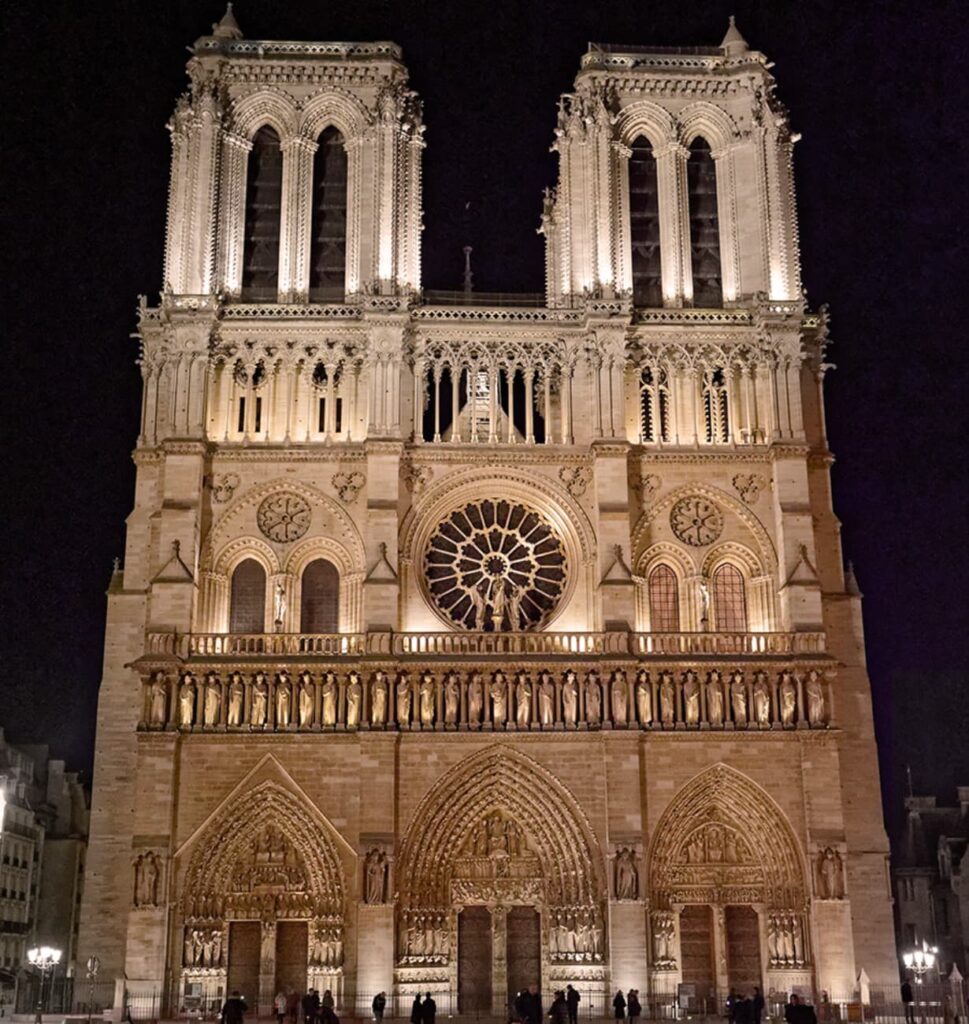
For historic facades, the lighting design must be approached with care. It’s not just about illumination but about paying homage to the structure’s history, ensuring that the lighting enhances its beauty without overshadowing its significance.
LED Lighting Options for Facades
Diving deeper into the world of facade lighting, let’s explore the LED lights that are commonly used to bring these architectural marvels to life:
LED Wall Washers: These are designed to illuminate large surfaces uniformly. They’re perfect for showcasing the overall structure of a building.
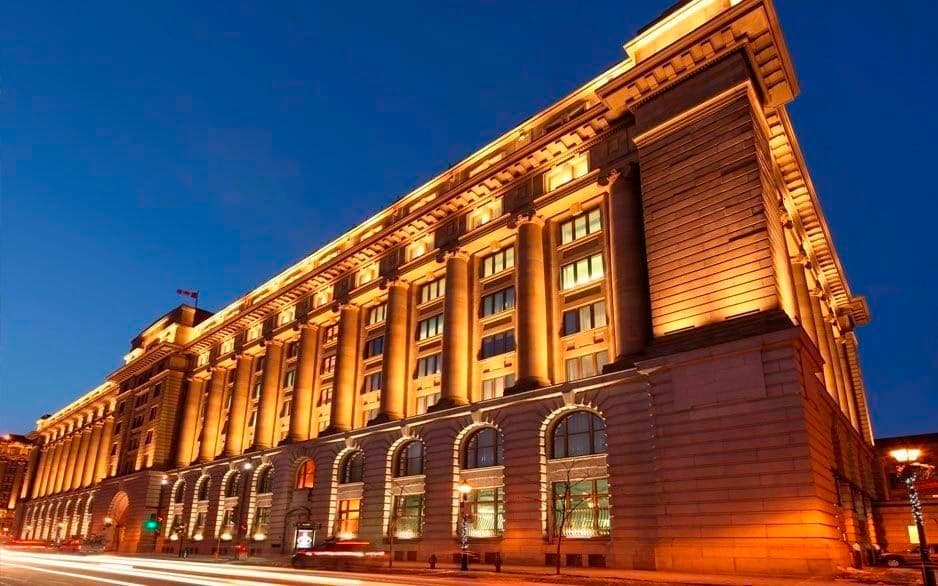
LED Spotlights: These are used to focus light on specific architectural details or features, creating a dramatic effect.
LED Strip Lights: Flexible and versatile, these can be used to outline shapes, windows, or other architectural elements. They’re also great for creating ambient effects.
LED Floodlights: These provide broad and powerful illumination, suitable for lighting up large facades or for security purposes.
LED Linear Lights: These are often used to create continuous lines of light along edges, borders, or any linear architectural feature.
LED Grazing Lights: Positioned close to the facade, they are used to emphasize textures on the surface, creating a grazing light effect.
LED Uplights and Downlights: These are used to cast light upwards or downwards on a facade, creating dynamic lighting effects and shadows.
LED Pixel Lights: These are individual LED points that can be programmed for color-changing effects, allowing for dynamic and interactive light displays on facades.
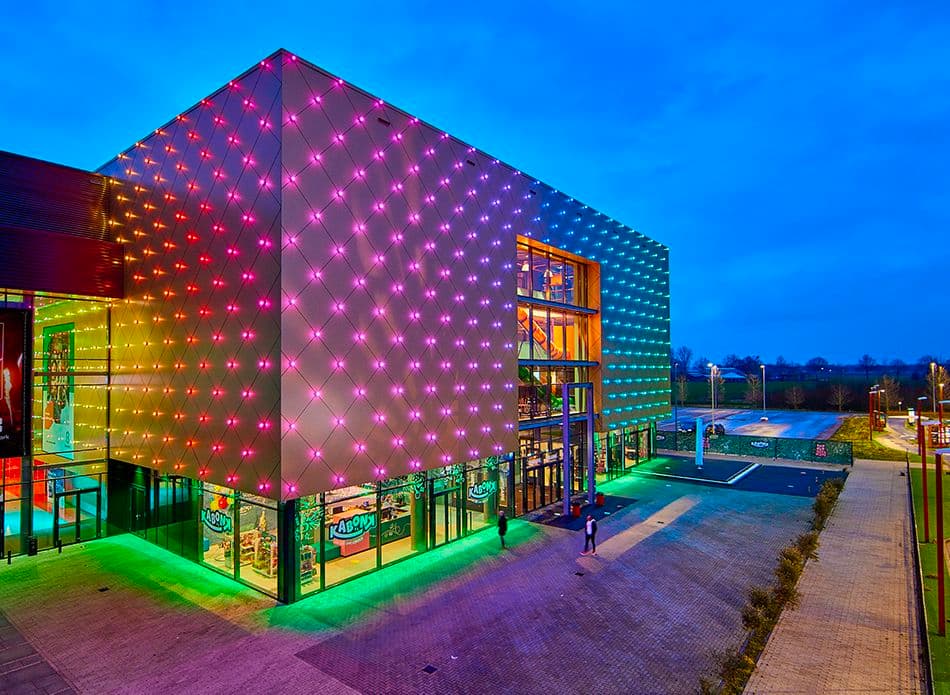
LED Recessed Lights: Embedded into walls or ceilings, these provide a sleek look, illuminating facades without the light fixtures being prominently visible.
LED Cove Lights: Positioned within ledges, recesses, or valances, these provide indirect lighting, creating a soft glow along the edges or corners of a building.
When selecting LED lights for facade lighting, it’s crucial to weigh factors like architectural style, desired effects, energy efficiency, and maintenance. The right LED choices, placed strategically, can redefine a building’s nighttime persona, making it a neighborhood’s crown jewel.
Breaking Down Facade Lighting: What’s Inside?
Facade lighting is a blend of multiple components working together to create efficient and visually appealing exterior illumination.Let’s delve into the key components that make up a typical facade lighting system:
- Light Sources: These are the primary elements that produce light. In modern facade lighting, LED lights are the most popular choice due to their energy efficiency, longevity, and versatility.
- Fixtures/Housings: These are the protective casings that house the light sources. They come in various designs and finishes to complement the architectural style of the building and protect the lights from environmental factors.
- Mounting Hardware: This includes brackets, clamps, and other equipment used to securely attach the light fixtures to the building’s facade.
- Optical Systems: These are lenses or reflectors that shape and direct the light. They help in focusing, diffusing, or spreading the light as needed to achieve the desired lighting effect.
- Control Gear: This encompasses drivers, ballasts, and transformers that regulate the power supply to the light sources, ensuring they operate efficiently and safely.
- Control Systems: Modern facade lighting often incorporates smart control systems that allow for dimming, color changing, and dynamic light sequences. These systems can be operated manually, through timers, or even via sensors.
- Sensors: Photocells, motion detectors, and other sensors can be integrated into the lighting system to automate operations. For instance, a photocell can ensure lights turn on at dusk and off at dawn.
- Cabling and Wiring: These provide the necessary electrical connections between the light sources, control gear, and power supply.
- Weatherproofing Elements: Given that facade lighting is exposed to the elements, components like gaskets, seals, and waterproof coatings are essential to protect the system from moisture, dust, and other environmental factors.
- Grounding and Safety Components: These ensure the entire system is grounded properly to prevent electrical hazards.
- Backup Systems: Some facade lighting setups might include backup power sources or systems to ensure the lights remain operational even during power outages.
Understanding these components is essential for anyone involved in the design, installation, or maintenance of facade lighting systems. It ensures the lighting not only looks good but also operates safely and efficiently for years to come.
How to Light a Facade?
Creating the perfect facade lighting design is both an art and a science. It requires a harmonious blend of aesthetics, functionality, and technology. While the task can be complex, especially when trying to mimic natural lighting, understanding the key principles and best practices can make the process smoother and more effective.
Uniform Glow: The Mastery of Consistent Brightness
Achieving uniform facade lighting might seem straightforward, but when illuminating a building’s exterior, there are several factors to consider. The iconic Empire State Building in New York City serves as a prime example of this mastery in action. Every evening, this historic skyscraper is bathed in a consistent glow, highlighting its Art Deco details and making it a standout feature of the city’s skyline. The building’s lighting team ensures that from its base to its iconic spire, every inch is uniformly lit, making it a beacon visible from miles away. The choice of lights, their placement, and the meticulous maintenance schedule all contribute to this consistent illumination, making it a shining example of uniform facade lighting.
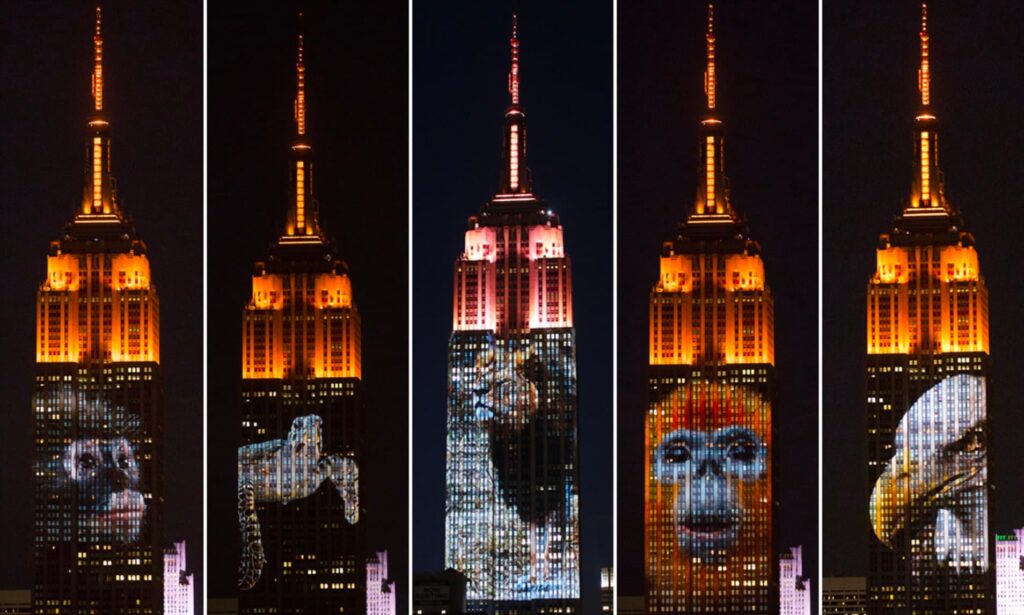
When aiming for uniform facade lighting, several factors come into play. The choice of lights is crucial, with floodlights often being the go-to for their wide beam that evenly covers large surfaces. The positioning of these fixtures is equally important, ensuring that the entire building’s exterior gets an even distribution of light. This involves considering the distance from the facade, as lights placed too far or too close can disrupt the desired effect. The angle at which the light strikes the facade also matters, as it can influence how the light spreads, highlighting architectural features without casting unwanted shadows.
It’s also essential to consider the intensity and color temperature of the lights. Adjustable intensity ensures consistent brightness across the facade, while a uniform color temperature prevents mismatched patches. Regular maintenance ensures that the lights function optimally, preserving the building’s aesthetic appeal. At the same time, care must be taken to avoid light pollution, ensuring that the illumination doesn’t spill over to unwanted areas. Lastly, the interplay between artificial and natural light, especially during twilight hours, should be harmonized to maintain a consistent and uniform facade appearance.
In essence, uniform facade lighting is about more than just brightness; it’s about ensuring the building’s exterior is presented in its best light, with every architectural detail shining through.
Lighting Without Seeing the Light: The Art of Hidden Illumination
In the realm of facade lighting, there’s a technique that stands out for its subtlety and elegance: the art of illuminating without revealing the light source. This method, often termed “hidden illumination,” is all about creating a visual experience where the focus remains solely on the illuminated facade, without any distractions from visible light fixtures.
One iconic example of this technique in action is the Louvre Pyramid in Paris. By day, this glass and metal structure stands as a modern contrast to the historic Louvre Museum. But by night, it transforms into a luminous beacon, glowing mysteriously without any visible light sources. The pyramid’s transparent panels are illuminated from within, and the light fixtures are cleverly concealed, making it seem as if the structure is radiating light from its core. This hidden illumination not only accentuates the pyramid’s geometric design but also creates a mesmerizing interplay of light and shadow on the surrounding grounds and the museum’s classical facade.
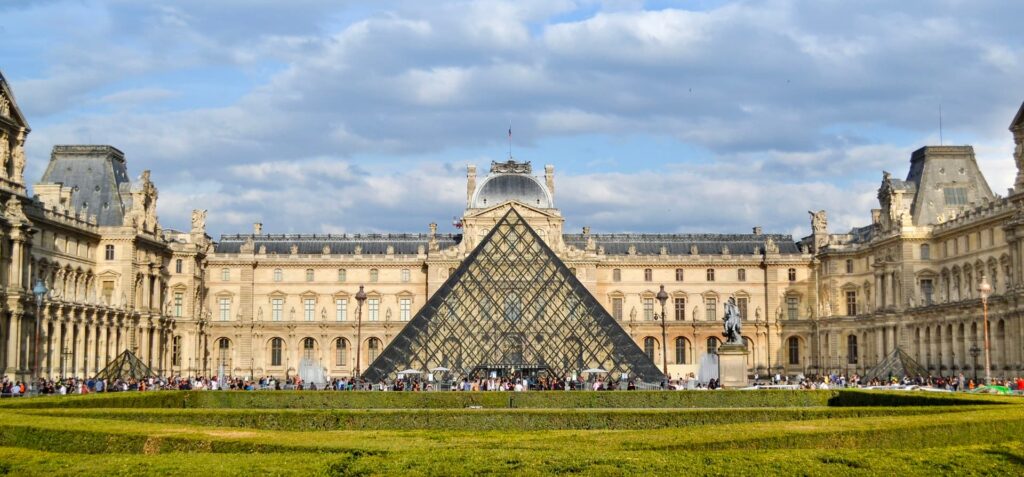
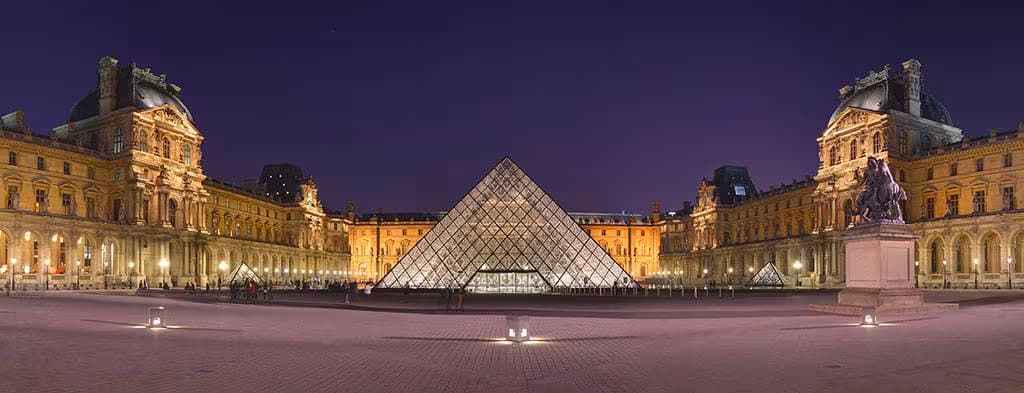
The primary goal of hidden illumination is to highlight the architectural features of a building, drawing attention to its design, textures, and patterns, while keeping the lighting equipment discreetly out of sight. This ensures that during nighttime, onlookers are presented with a pure, unobstructed view of the building, making it appear as if it’s glowing from within.
Achieving a lighting effect where the source remains concealed, yet the illumination is effective, demands careful planning and design. Recessed lighting techniques embed fixtures within the structure, ensuring the light shines without revealing its origin. Backlighting, shielded fixtures, ground uplighting, and integration with landscaping are other methods that contribute to this magical ambiance.
The beauty of “Lighting Without Seeing the Light” lies in its ability to create a captivating atmosphere. The building seems to come alive at night, its features accentuated, without any visible signs of artificial intervention. It’s a testament to the power of lighting design, where the unseen plays as crucial a role as the seen.
Spotlighted Features: The Craft of Accent Illumination
Accent lighting is designed to emphasize and draw attention to particular architectural features or elements of a building’s facade. Distinct from general or ambient lighting, which casts a uniform glow across an area, accent lighting is targeted and deliberate. Think of it as the spotlight that underscores the main attraction.
Consider the Eiffel Tower in Paris, a global icon that comes alive at night through the magic of accent lighting. While the tower itself is illuminated, accent lights are strategically placed to highlight its intricate iron lattice work, emphasizing the craftsmanship and design that went into its construction. At regular intervals, a series of sparkling lights dazzle onlookers, turning the tower into a glittering spectacle against the night sky. This is accent lighting at its finest, transforming an already impressive structure into a radiant beacon of art and engineering.
In facade lighting, accent lighting is instrumental in highlighting a building’s distinctive design elements, textures, and intricate details. It can illuminate a grand entrance, emphasize the texture of materials like brick or stone, or showcase an ornate balcony or sculpture. The essence of accent lighting lies in its ability to make certain features pop, ensuring they capture the observer’s attention.
The key to effective accent lighting is the use of fixtures that emit a focused beam of light. These fixtures often have a narrower beam spread compared to standard floodlights, allowing for meticulous control over the illumination. Spotlights, directional lights, and track lights are typically chosen for this role. Their precision makes them akin to an artist’s brush, adept at highlighting the subtle and intricate details of a structure.
While accent lighting is predominantly about aesthetics, it also has functional benefits. It can guide visitors by illuminating pathways or entrances, and it can bolster security by shining light on specific, potentially vulnerable areas.
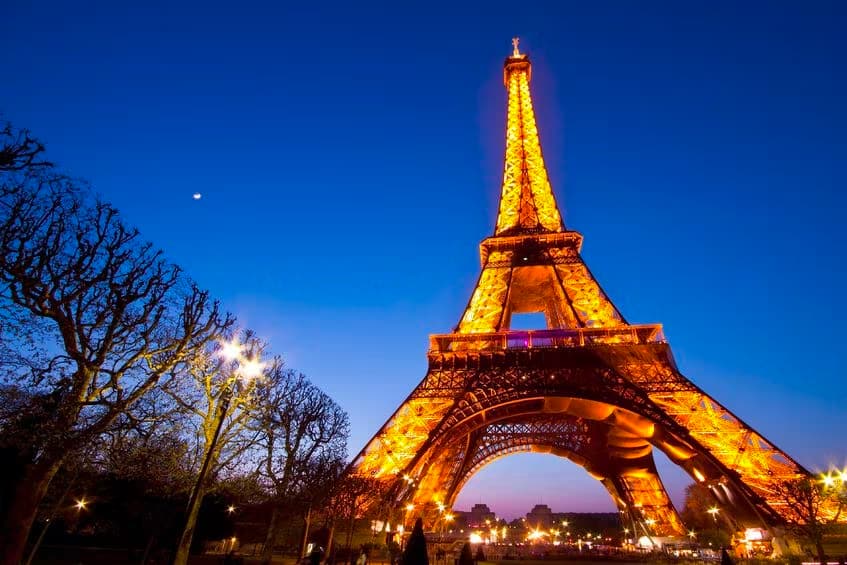
Depth in Design: The Strategy of a Layered Approach
A layered approach to facade lighting is akin to crafting a symphony. Different layers of light come together, each playing its part, to create a harmonious and captivating visual experience. Start with ambient lighting to set the base, add task lighting for functionality, and finish with accent lighting to highlight and dramatize.
Take, for instance, the iconic Sydney Opera House in Australia. The building, with its unique shell-like structures, employs a layered lighting approach to stunning effect. Ambient lighting bathes the entire structure in a soft glow, ensuring that the Opera House remains a beacon on the harbor. Task lighting is strategically used on pathways, entrances, and staircases, ensuring safety and functionality for visitors. But it’s the accent lighting that truly brings the building to life. Precisely aimed spotlights emphasize the sharp angles and curves of the shells, creating dramatic shadows and contrasts. During special events, colored lights and projections add another layer, turning the facade into a canvas for dynamic art displays. This combination of different lighting layers ensures that the Sydney Opera House is not just a building but a luminous spectacle, captivating to all who lay eyes on it.
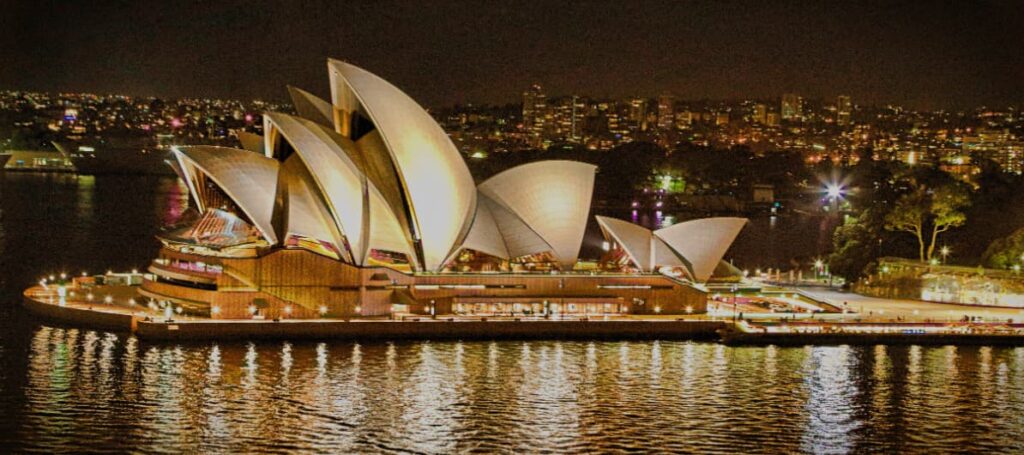
Consider the Environment & Embrace Dynamic Interactions
Always remember, a building doesn’t stand alone. It’s a part of its environment, its neighborhood, its city. The lighting should not only enhance the building but also complement its surroundings, ensuring that the building and its environment dance in harmony, under the same rhythm of light.
Take, for instance, the iconic Sydney Opera House in Australia. This architectural marvel isn’t just illuminated for its own sake. The lighting design takes into account its prime location by the harbor and its significance to the city’s skyline. During special events like the Vivid Sydney festival, the Opera House is adorned with dynamic light projections. These projections not only highlight its unique sail-like structures but also reflect off the waters of the harbor, creating a mesmerizing spectacle. The use of vibrant colors evokes various emotions, setting the mood for the festival and turning the building into a visual celebration. Moreover, the lighting is interactive, responding to music and live performances, making it a dynamic part of the event. This approach not only emphasizes the building’s iconic design but also harmonizes with the surrounding waterscape and skyline, ensuring that the entire area comes alive in a coordinated display of light, color, and movement.
Modern facade lighting is more than just illumination. It’s about creating a dialogue between the building, its environment, and the people who interact with it, turning static structures into dynamic canvases that tell a story.
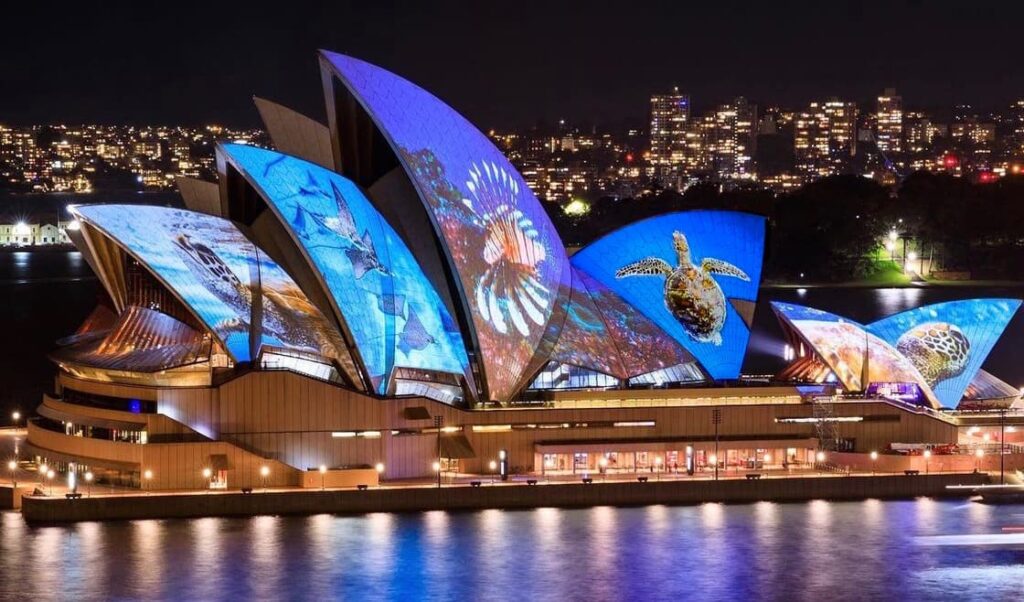
In the world of facade lighting, emotion and technique intertwine. It’s about understanding the soul of the building, the story it wants to tell, and then using light to narrate that tale. Every beam, every shadow, every hue is a word in that story, making the building not just a structure, but a living, breathing entity that communicates with those who behold it.
Tips for Choosing the Right Facade Lighting
- Detailed Facade Analysis: Think of your facade as a canvas. Before you paint with light, you need to understand its texture, its nuances, and its unique features. Is it rough brick or smooth marble? Does it have intricate carvings or modern geometric patterns? Recognizing these details will guide your lighting choices, ensuring each material and feature is illuminated to its best advantage.
- Layering is Key: Just as a masterful painting isn’t created with a single brushstroke, a well-lit facade isn’t achieved with one type of light. It’s about layering. Start with a soft ambient glow, add focused beams to highlight architectural gems, and then ensure practical areas like entrances are clearly lit.
- Control Light Spillage: Precision is paramount. Imagine the facade as a stage; you want the spotlight on the performers, not blinding the audience. Using fixtures with exact beam angles and adding accessories like louvers can ensure light graces only the intended areas, preventing glare or intrusion into unwanted spaces.
- Consider the Building’s Vertical Gradient: A building isn’t flat; it’s a vertical landscape. The bustling street level is a world away from the serene top floors that touch the sky. Recognize this gradient and adjust lighting intensity to ensure every level, from ground to roof, is perfectly lit.
- Dynamic vs. Static Lighting: Ask yourself: Do you want a timeless, unchanging glow or a facade that evolves, perhaps shimmering during festive seasons or pulsating with the rhythms of the city? This decision will shape your choice between static and dynamic lighting systems.
- Integrate Sensors for Adaptive Lighting: Nature is unpredictable. A cloudy evening or a bright moonlit night can change the ambiance. Integrate sensors that read the environment, allowing your facade to adapt, dimming or brightening in harmony with nature’s whims.
- Understand Shadows: Shadows are the silent storytellers of lighting. They can create depth, drama, and intrigue. But, unchecked, they can also hide beauty. It’s a dance of light and dark, and understanding where to cast shadows and where to banish them is crucial.
- Weather and Seasonal Considerations: Seasons change, and so does the sky’s canvas. The golden hues of autumn or the stark brightness of winter can influence how your building should be lit. And always remember, Mother Nature can be harsh; ensure your fixtures can brave her storms.
- Safety First: A beautifully lit facade is a joy, but never at the cost of safety. Ensure ground-level fixtures are tamper-proof. Also, ensure there are no dark corners, which could be potential hiding spots or security risks.
- Future-Proofing: Time changes everything, including buildings. Maybe there’ll be a new extension or a change in facade material. Ensure your lighting system is adaptable, ready to evolve with the building’s future transformations.
- Collaborate with Landscape Designers: A building isn’t an island. It’s part of a larger landscape, perhaps with gardens, trees, or water features. Collaborate with landscape designers to ensure your facade lighting is in harmony with its surroundings, creating a unified visual symphony.
- Highlighting Architectural Gems: Every building has its standout features, whether it’s an ornate entrance, a uniquely textured wall, or intricate architectural details. It’s essential to identify these areas and ensure they’re well-lit. However, it’s equally important to recognize that not every part of a facade needs the same level of illumination. By selectively highlighting certain areas, you can create a sense of depth, contrast, and drama. This approach not only saves energy but also directs viewers’ attention to the building’s most impressive features.
Conclusion
Facade lighting is more than just illumination; it’s the art of bringing architecture to life after sunset. In today’s architectural landscape, the right lighting can elevate a building from ordinary to extraordinary, creating landmarks that captivate and inspire. It’s not just about visibility; it’s about creating moods, highlighting design intricacies, and making a statement.
If you’re looking to transform your building into a nighttime masterpiece, don’t leave it to chance. Consult with our team of experts from Sinolumi LED Ltd., and let us craft a lighting design that not only illuminates but also resonates. Your building deserves to shine; let us help you make that happen.
